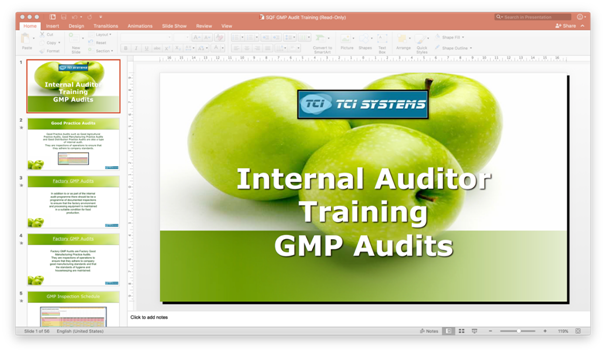
SQF Code Training
SQF Practitioners, Consultants and Trainers
The SQF Code – A HACCP Based Supplier Assurance Code for the Food Industry is a GFSI benchmarked standard which is recognized for a wide range of industry scopes. The format of the standard is such that there is a compulsory module, Module 2: SQF System Elements and an industry sector specific module of food safety fundamentals for example in the case of food manufacturing this is Module 11: Food Safety Fundamentals – Good Manufacturing Practices for Processing of Food Products.
SQF Practitioners, Consultants and Trainers will all require a fundamental understanding of the SQF Code with consultants and trainers there is a need for more extensive knowledge in order to carry out their roles.
For an SQF Practitioner this knowledge can be gained by attending an “Implementing SQF Systems” training course through a licensed SQF Training Center, taking the online training course available at SQFI, and/or self learning by reading SQF Code (Current Edition 7.1 July 2013) and the SQF Code Guidance Documents which are available to download for free on the SQFI website. Currently there are guidance documents for Module 2: SQF System Elements and Module 11: Food Safety Fundamentals – Good Manufacturing Practices for Processing of Food Products. The Implementing SQF Systems training course is not mandatory for SQF practitioners, but is recommended by the SQFI. It is also possible to demonstrate competency in knowledge of the SQF Code by taking an Implementing SQF Systems online exam without taking the Implementing SQF Systems training course.
For SQF professionals such as Consultants and Trainers the Safe Quality Food Institute offers specific SQF training to ensure that licensed SQF Professionals are competent. There are SQFI licensed Training Centers in the United States, Australia, Canada, Ireland and Mexico which are able to provide a two-day course in “Implementing SQF Systems” or alternatively there is an interactive online course available. The nearest licensed training center can be found using a directory search on the SQFI website. Although both courses are identical in content the online course has no fixed timescale so can be taken at your leisure. Online SQF Systems training courses and the online exam are provided by Alchemy Systems, again there is link to register for online courses on the SQFI website. The cost of the Implementing SQF Systems online course is a little pricey at $900 US although the pluses are convenience and savings on expenses such as travel accommodation and food. Both courses offer guidance in preparing and implementing an SQF System, controlling hazards and developing food safety plans and preparing for the SQF audit.
As well as demonstrating an understanding of the SQF Code, SQF Auditors and SQF Consultants need to demonstrate their competency in developing Food Safety Plans and need to complete a HACCP training course. SQF Auditors also need to complete the Auditing Systems Course and receive a Certificate of Attainment.
Auditors can apply for registration on the SQFI website. In order to register as an SQF Auditor applicants will need to demonstrate competency in terms of experience, training courses completed and knowledge of products. These competencies include having to complete a Lead Auditor training course of 40 hrs duration and a HACCP Training course. Auditors also need to have over 120 hours of audit experience and have worked in the food industry for at least 5 years. Requirements are more stringent for Auditors working in high risk food sectors and auditors need to have a university degree in a discipline related to the food sector category.
Similarly consultants can register on the SQFI website. There are two levels of registration general processes and high risk processes, again the requirements are more stringent for high risk processes. Both levels require evidence of on-the-job training, HACCP training and SQF systems training plus relevant food safety work experience including the development of pre-requisite programs and in developing, validating, verifying and maintaining HACCP systems. Consultants for high risk processes are also required to have a relevant degree to the food sector category from a recognized institution.
The process of gaining BRC certification will vary with the size and complexity of an organisation and the extent to which food safety system have been developed.
For those with knowledge of other GFSI benchmarked standards familiarization with the SQF Code should be straightforward as although the SQF Code has SQF specific requirements generally it contains what would be regarded widely recognized food safety management elements and prerequisite requirements. There are areas where the SQF Code specifically refers to training and appropriate training should be in place. Module 2: SQF System Elements describes management responsibility, the requirement for a trained SQF practitioner that the responsibility for establishing and implementing the training needs of the organization should be defined and an employee training program implemented with a Training Skills Register for all relevant personnel. When developing a Business Continuity Plan the crisis management team should be trained. Contract Service Providers should define training requirements of contract personnel. For SQF level 3 certification sensory evaluations are required to be conducted by trained personnel. Staff conducting internal audits shall be trained in internal audit procedures.
Section 2.9 prescribes Training Requirements and the need for training of personnel carrying out critical tasks related to the effective implementation and maintenance food safety management system this includes HACCP training for staff involved in developing and maintaining food safety plans. The SQF Code requires training in good agricultural practices, good aquaculture practices, or good manufacturing practices and in applying food regulatory requirements as appropriate. Specific training should be given to personnel who are involved in measures identified as part of the food safety plan and the maintenance of food safety/product conformity. Clause 2.9.3 defines the requirement for instructions, clause 2.9.5 requires that training should be in an appropriate language and there is also a requirement for refresher training.
In the modules where Food Safety Fundamentals are prescribed such as good agricultural practices, good aquaculture practices, or Good Manufacturing Practices there are also requirements for training for example in the management of pests. There should be a staff awareness program and training in the use of pest control chemicals, pesticides and other toxic chemicals should be applied by properly trained personnel and inspections for pest activity should be carried out by trained personnel. There is a requirement for pest control contractors to use only trained and qualified operators.
Step 3 Gap Analysis – You will need to carry out a gap analysis to identify where your current food safety management system fails to meet the requirement of the BRC standard. BRC Global Standards Self-Assessment Tool which is provided by BRC as one of their free Guidance Documents here
There are training requirements for cleaning and sanitation operations such that only trained personnel should handle sanitizers and detergents and also in the management of hazardous chemical and toxic substance storage facilities which should be secure and restrict access only to those personnel with formal training in the handling and use of hazardous chemicals and toxic substances.

